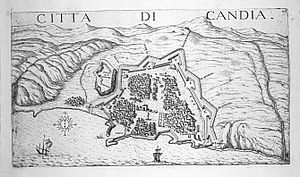| Siege of Candia | |||||||||
|---|---|---|---|---|---|---|---|---|---|
| Part of the Cretan War (Sixth Turkish-Venetian War) | |||||||||
 The city of Candia with its fortifications, 1651 |
|||||||||
|
|||||||||
| Belligerents | |||||||||
| Commanders and leaders | |||||||||
| Köprülü Fazıl Ahmed | Francesco Morosini | ||||||||
| Strength | |||||||||
| 60,000 soldiers
20,000 workers and miners | 10,000 European allies men
12,000 Greek & Venetians Citizens |
||||||||
| |||||
The Siege of Candia (modern Heraklion, Crete) was a military conflict in which Ottoman forces besieged the Venetian-ruled city and were ultimately victorious. Lasting from 1648 to 1669, it was the longest siege in history.
Background
In the 17th century, Venice's power in the Mediterranean was waning, as Ottoman power grew. The Venetian Republic believed that the Ottomans would use any excuse to pursue further hostilities.
In 1644, the Knights of Malta attacked an Ottoman convoy on its way from Alexandria to Constantinople. They landed at Candia with the loot, which included part of the Sultan's harem, returning from a pilgrimage to Mecca.
In response, 60,000 Ottoman troops led by Yussuf Pasha disembarked on Venetian Crete and occupied La Canea (modern Chania) and Rettimo (modern Rethimno). Both of these cities took two months each to conquer. Between 1645 and 1648, the Turks occupied the rest of the island and prepared to take the capital, Candia.
Siege
The siege of Candia began in May 1648. The Turks spent three months investing the city, cutting off the water supply, and disrupting Venice's sea lanes to the city. For the next 16 years, they would bombard the city to little effect.
The Venetians, in turn, sought to blockade the Ottoman-held Dardanelles to prevent the resupply of the Ottoman expeditionary force on Crete. This effort led to a series of naval actions. On 21 June 1655 and 26 August 1656, the Venetians were victorious, although the Venetian commander, Lorenzo Marcello, was killed in the latter engagement. However on 17–19 July 1657, the Ottoman navy soundly defeated the Venetians and the Venetian captain, Lazzaro Mocenigo, was killed by a falling mast.
Venice received more aid from other western European states after the 7 November 1659 Treaty of the Pyrenees and the consequent peace between France and Spain. However, the Peace of Vasvár (August 1664) released additional Ottoman forces for action against the Venetians in Candia.
In 1666, a Venetian attempt to recapture La Canea failed. The following year, Colonel Andrea Barozzi, a Venetian military engineer, defected to the Turks and gave them information on weak spots in Candia's fortifications. In 1669, a French land/sea expedition under Mocenigo not only failed to lift the siege, but also lost on 24 July the fleet's vice-flagship, La Thérèse a 900-ton French warship armed with 58 cannons, to an accidental explosion. This dual disaster was devastating to the morale of the city's defenders.
Apparently chastened by their failed relief effort and the loss of so valuable a warship, the French abandoned Candia in August 1669 leaving Captain General Francesco Morosini, the commander of Venetian forces, with only 3,600 fit men and scant supplies to defend the fortress. He, therefore, accepted terms and surrendered to Ahmed Köprülü, the Grand Vizier of Albanian origin of the Ottoman Empire of on 27 September 1669. However, his surrender without first receiving authorization to do so from the Venetian Senate made Morosini a controversial figure in Venice for some years afterward.
As part of the surrender terms, all Christians were allowed to leave Candia with whatever they could carry while Venice retained possession of Gramvousa, Souda and Spinalonga, fortified islands that shielded natural harbors where Venetian ships could stop during their voyages to the eastern Mediterranean. After Candia's fall, the Venetians somewhat offset their defeat by expanding their holdings in Dalmatia.
It is said that when news of Candia's fall reached Pope Clement IX in October he immediately fell ill and, two months later, died.
Other participants
- Knights of Malta fought at the Siege of Candia (in Crete) in 1668. In fact, by raiding an Ottoman convoy en route from Alexandria to Constantinople in 1644 and capturing part of the sultan's harem, they could be said to have precipitated the crisis.
- Francois de Beaufort, who died there.
- Philippe de Montault-Bénac, marshal under the duke of Beaufort.
- Philippe de Vendôme, the nephew of the duke of Beaufort
- Vincenzo Rospigliosi, admiral of the fleet and Pope Clement's nephew.
- Charles de Sévigné.
In fiction
The Siege of Candia is an important part of the background to the historical novel "An Instance of the Fingerpost", where a major protagonist is a Venetian veteran of that siege and several plot developments become clear through extensive flashbacks to the Candia events.
See also
- Naval battles of the Cretan Wars
- History of the Republic of Venice
- Ottoman Navy
- Ottoman wars in Europe
References
- A Very Brief History of Crete, Stelios Jackson
- Crete: History and culture, Turkish Occupation (1669–1898)
- The War for Candia, by the VENIVA consortium.
- Venice Republic: Renaissance, 1645-69 The war of Candia, by Marco Antonio Bragadin.
- Knights of Malta - Order of St John.
Template:Ottoman battles Template:Major Ottoman sieges
| This page uses content from the English language Wikipedia. The original content was at Siege of Candia. The list of authors can be seen in the page history. As with this Familypedia wiki, the content of Wikipedia is available under the Creative Commons License. |
Deaths
| Father | Mother | Death date | Age at death | |
|---|---|---|---|---|
| Josias II. von Waldeck-Wildungen (1636-1669) | Philipp VI. von Waldeck-Wildungen (1613-1645) | Anna Katharina zu Sayn-Wittgenstein-Wittgenstein (1610-1690) | 16 July 1669 | 33 |